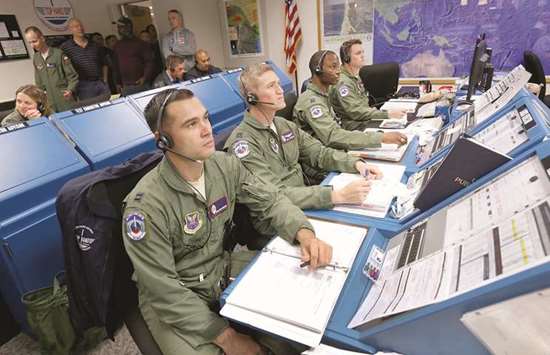VANDENBERG AIR FORCE BASE, California — A Minuteman III missile inside the silo known as Foxtrot 2 in Montana was on alert for nearly half a century, ready to fire a more than 300-kiloton hydrogen bomb to an adversary anywhere in the world in about 30 minutes.
That mission ended in Fe
bruary, when an Air Force crew ventured out onto the frozen Great Plains with a special crane and pulled it out of the hole. It was headed for sunny California.
The ageing missile had been selected for a test-fire, to prove it still worked and could hit a bull’s-eye — within several hundred feet, anyway — on a target in the South Pacific, 4,200 miles away.
About four times every year, the Air Force goes through the exercise of pulling an ICBM out of a silo, removing its nuclear warhead and sending it to Vandenberg Air Force Base near Lompoc for a test launch.
The tests, which cost $18 million each, not only give the Air Force crucial data on the function of its ageing missiles, but also send a clear international signal, complete with high-definition photography, of America’s continued ability to launch a nuclear strike.
The missile selected for testing had been chosen randomly in an improbable but apparently long-standing Air Force tradition: A map of missile sites was put on a wall and an officer was selected to throw a dart at it. The dart hit Foxtrot 2’s location, about 22 miles northeast of tiny Augusta, Montana, sometimes called the “last original cow town in the West.”
“We can’t think of a more random method than that,” said Major General Fred Stoss, operations commander for the Global Strike Command. Stoss recalled that when it was his turn to select a missile, it took him a couple of throws to even hit the list — a fact not to be taken as predictive of the Air Force’s actual targeting capabilities in the event of nuclear war.
The missile was transported by truck to Vandenberg, where the Air Force has been testing its ICBMs for more than half a century.
A dozen launch officers and maintenance men and women from the 341st Missile Wing at Malmstrom Air Force Base in Montana left their Arctic-like conditions and drove to Vandenberg for a visit that would span more than two months.
Once there, the test missile was reassembled, inserted into a silo and powered up. The missile hardware dates to the 1960s, the same era when the US aerospace industry built the Apollo spacecraft that took men to the moon. Unlike the moon rockets, the ICBMs are still at work.
The missiles wait in their underground silos with the gyroscopes spinning inside their guidance systems around the clock, ready to launch in minutes if the president orders a nuclear strike. (The missile housed in Foxtrot 2 had clocked 32,500 on its guidance system by the time it was extracted and shipped to Vandenberg.)
Once at the test base in California, two officers from Malmstrom were assigned to an underground launch control centre that resembles their actual launch facility in Montana — and the preparations began.
It would be a full month later, just after midnight, when missile launch officers would issue a command to open a 110-ton door over the test silo.
Simultaneously, they each turned keys on their underground consoles, sending an electronic signal to the 79,432-pound weapon: ignition.
The missile roared powerfully out of the silo, a trail of flames and rocket exhaust arcing behind it in the night sky. A brief message appeared on their display screen: “Missile away.”
The test mission was no doubt a respite for the Air Force crews from what is often described as a stressful job. Missile launch officers are locked in their underground capsules for 24-hour shifts. Harsh weather conditions or broken equipment sometimes require them to stay underground for four days or more.
The vibe is decidedly different at Vandenberg. The base is located on 150 square miles of pristine California coast. It has three beaches and a network of hiking trails. Nearby golf courses abound.
The launch centre looks faintly like a Montana ranch house, complete with a spartan bedroom and small kitchen. A rumbling freight elevator takes the crew down to the launch capsule, which is protected by heavy steel blast doors. On the walls of the elevator shaft, crews have inscribed their names on the walls and painted replicas of their mission patches. Decades of the test programme’s past is told in more than a hundred of these drawings.
“There’s a lot of history here,” said Captain Christopher McCollum, who works at the base’s 576th Flight Test Squadron.
For the test on May 3, the unit’s patch featured a human skull draped in a black hood, standing in front of a mushroom cloud. The inscription is in Latin, Conmercium Mortem — “Dealing Death.”
When the test launch got underway, the missile lit up the California coastline for miles as it soared across the Pacific.
Its powerful roar took about 20 seconds to travel from the silo to the closest observation point, where Air Force personnel, their families and visitors watched from metal bleachers. Taco chips and cookies, next to a bowl for contributions, were set out for the late-night event.
The Minuteman has three solid rocket stages and a fourth liquid stage that fine-tunes the warhead’s trajectory before it is released.
During the initial minutes of the test flight, the first two stages could be seen falling off into the Pacific, where they sank into the deep ocean. After a few minutes, the tiny white dot disappeared on its way to Kwajalein Atoll, the site of an Army garrison in the Marshall Islands that was captured from Japan in World War II.
The elaborate test involved a crew of 200. Officers at the launch centre monitored the flight from three rows of consoles. Meanwhile, at the Western Range Operations Control Center, located in another area of the base, officers prepared to destroy the missile if it veered off course.
On its trajectory across the globe, the missile reached 700 miles into space, nearly three times higher than the International Space Station. One goal of the flight was to clear a Chinese spacecraft by at least 125 miles.
No dartboard was used for this job. A sophisticated software system designed the route to avoid the other spacecraft and space junk that orbit Earth.
The dummy warhead — actually a re-entry vehicle packed with instruments — re-entered Earth’s atmosphere about 28 minutes after it launched, travelling 4 miles per second, glowing red-hot. It plunged into the lagoon at Kwajalein.
It was destroyed when it hit the water and the debris sank to the bottom, joining World War II wreckage in one of the largest lagoons in the Pacific.
Tracking systems at Mount Wilson in Los Angeles County, a Navy base in Hawaii and the Kwajalein Atoll had monitored the flight from start to finish. Air Force officials declared it a success. How close did it come to the bull’s-eye? That remained a secret.
For most of the staff, the launch itself was the main event.
“It is a rare opportunity for a missileer to actually launch a missile,” said Lt. Eric Schoenhals, commander of the launch team. “It has been kind of a childhood dream of mine, so it is exciting … to really launch one and see it burn in the sky.” — Los Angeles Times/TNS
* Vartabedian reported
from Vandenberg and
Hennigan from Washington

READY, STEADY: Officers at Vandenberg Air Force Base prepare for a Minuteman III missile test.


